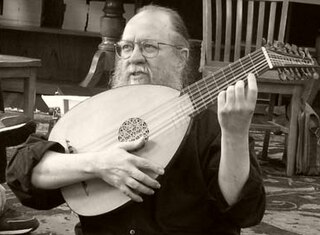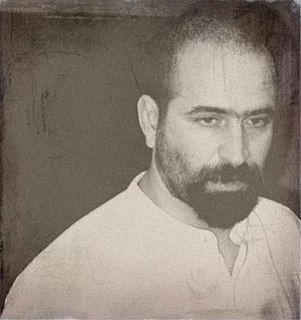Related Research Articles

The classical guitar is a member of the guitar family used in classical music. An acoustic wooden string instrument with strings made of gut or nylon, it is a precursor of the modern acoustic and electric guitars, both of which use metal strings. Classical guitars are derived from the Spanish vihuela and gittern in the fifteenth and sixteenth century, which later evolved into the seventeenth and eighteenth-century Baroque guitar and later the modern classical guitar in the mid-nineteenth century.

A lute is any plucked string instrument with a neck and a deep round back enclosing a hollow cavity, usually with a sound hole or opening in the body. It may be either fretted or unfretted.

The viol, viola da gamba, or informally gamba, is any one of a family of bowed, fretted and stringed instruments with hollow wooden bodies and pegboxes where the tension on the strings can be increased or decreased to adjust the pitch of each of the strings. Frets on the viol are usually made of gut, tied on the fingerboard around the instrument's neck, to enable the performer to stop the strings more cleanly. Frets improve consistency of intonation and lend the stopped notes a tone that better matches the open strings. Viols first appeared in Spain in the mid to late 15th century and were most popular in the Renaissance and Baroque (1600–1750) periods. Early ancestors include the Arabic rebab and the medieval European vielle, but later, more direct possible ancestors include the Venetian viole and the 15th- and 16th-century Spanish vihuela, a 6-course plucked instrument tuned like a lute that looked like but was quite distinct from the 4-course guitar.

Patrick O'Brien was an American guitarist and lutenist born in New York. He was a recording artist, but was best known as a pedagogue in the field of early plucked instruments in America, and an expert in musicians' hand anatomy. He has worked with musicians on many instruments, reworking their technique around repetitive stress injuries and breakdowns of coordination.
Caspar Brötzmann is a German guitarist, vocalist and bandleader.
John Schneider is an American classical guitarist. He performs in just intonation and well-temperament, including Pythagorean tuning, including works by Lou Harrison, LaMonte Young, John Cage, and Harry Partch. He often arranges pieces for guitar and other instruments such as harp or percussion.

Francesco Corbetta was an Italian guitar virtuoso, teacher and composer. Along with his compatriots Giovanni Paolo Foscarini and Angelo Michele Bartolotti, He was a pioneer and exponent of the combination of strummed and plucked textures referred to today as "mixed" style.

The Baroque guitar is a string instrument with five courses of gut strings and moveable gut frets. The first course sometimes used only a single string.

Roman Turovsky-Savchuk is an American artist-painter, photographer and videoinstallation artist, as well as a lutenist-composer, born in Ukraine. His musical works were published under various pseudonyms, including Johann Joachim Sautscheck.

The mandore is a musical instrument, a small member of the lute family, teardrop shaped, with four to six courses of gut strings and pitched in the treble range. Considered a French instrument, with much of the surviving music coming from France, it was used across "Northern Europe" including Germany and Scotland. Although it went out of style, the French instrument has been revived for use in classical music. The instrument's most commonly played relatives today are members of the mandolin family and the bandurria.

Angelo Michele Bartolotti was an Italian guitarist, theorbo player and composer. Bartolotti was probably born in Bologna, Italy, as he describes himself as "Bolognese" on the title page of his first guitar book and "di Bologna" on the title page of his second.
Toyohiko Satoh is a Japanese lutenist and composer.

Oleg Vitalyevich Timofeyev, is an American musicologist, specializing in lute and Russian guitar. He is best known for his pioneering work in the discovery, promotion, interpretation, and authentic performance of the repertoire for the 19th- and 20th-century Russian seven-string guitar.
Rolf Lislevand, is a Norwegian performer of Early music specialising on lute, vihuela, baroque guitar and theorbo.
Mårten Oskar Falk is a Swedish classical guitarist. He studied at the Conservatory of the Ecole Normale de Musique de Paris under Alberto Ponce.

Stephen Barber is an American composer, arranger and musician, known for working with David Byrne, Keith Richards, John Legend, Natalie Merchant, T Bone Burnett, Rosanne Cash, The London Symphony Orchestra, Christopher Cross, Bonnie Raitt, Indigo Girls, Michael Stipe and Shawn Colvin.
Lex Eisenhardt is a performer and recording artist on early plucked instruments, such as the vihuela, the baroque guitar, and the 19th-century Romantic guitar. He studied lute and guitar at the Utrecht Conservatory. In 1981 he was appointed professor of guitar and early plucked instruments at the Sweelinck Conservatorium. In the forefront of the Historically Informed Performance (HIP) on the guitar, Eisenhardt was the first to make several gramophone recordings with music by the Catalan composer Fernando Sor on a period instrument from the early 19th century. He has given solo recitals and lectures in many European countries, Australia, and the United States. Well-known guitarists such as Johannes Moller and Izhar Elias studied with him.
References
- ↑ "About the Society". The Lute Society. Retrieved 2012-10-17.CS1 maint: discouraged parameter (link)
- ↑ Hall, Monica (2003). Baroque guitar stringing: a survey of the evidence - Monica Hall, Lute Society (Great Britain) - Google Books. ISBN 9780905655406 . Retrieved 2012-10-17.CS1 maint: discouraged parameter (link)
- ↑ "Monica Hall - Baroque Guitar Research". Monicahall.co.uk.
- ↑ "The Lute Society of America — Publications — 2011 Quarterly Table of Contents". Cs.dartmouth.edu. Retrieved 2012-10-17.CS1 maint: discouraged parameter (link)
- ↑ Hall, Monica. "Author Affiliations". The chittarra atiorbata and the guittare theorbée: a reappraisal. Oxford Journals. Archived from the original on 15 April 2013. Retrieved 16 October 2012.CS1 maint: discouraged parameter (link)
- ↑ Russell, Craig. "Rebuttal to Monica Hall's Communication". California Polytechnic State University. Retrieved 16 October 2012.CS1 maint: discouraged parameter (link)